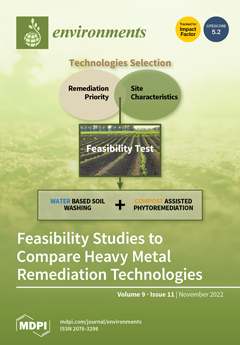This research investigates the impact of controlling pandemic measures on the characteristics of atmospheric particulate matter (PM), with specific concern to its toxicity, measured by its oxidative properties. The investigated PM
10 samples were collected in the metropolitan area of Milan during the
[...] Read more.
This research investigates the impact of controlling pandemic measures on the characteristics of atmospheric particulate matter (PM), with specific concern to its toxicity, measured by its oxidative properties. The investigated PM
10 samples were collected in the metropolitan area of Milan during the epidemic lockdown, and their oxidative potential (OP) was assessed using ascorbic acid (AA) and dithiothreitol (DTT) acellular assays. During the full lockdown, we estimated reductions to 46% and 60% for nitrogen dioxide (NO
2) and black carbon (BC) concentrations, respectively, based on the aggregated 2018–2019 data of NO
2 and BC levels, used as baseline conditions. To quantify the impact of lockdown restrictions on PM oxidative activity, we studied the OP data measured in our laboratory on PM
10 filters and directly compared the results from 15–30 April 2020 with those from the same time span in 2019. The OP
AA values dropped to nearly 50%, similar to the concentration decrease in Elemental Carbon (EC) and traffic related metals, as well as to the variation in NO
2 level. Otherwise, the OP
DTT responses decreased to nearly 75%, as described by the corresponding reduction in Organic Carbon (OC) concentration and BC level.
Full article





